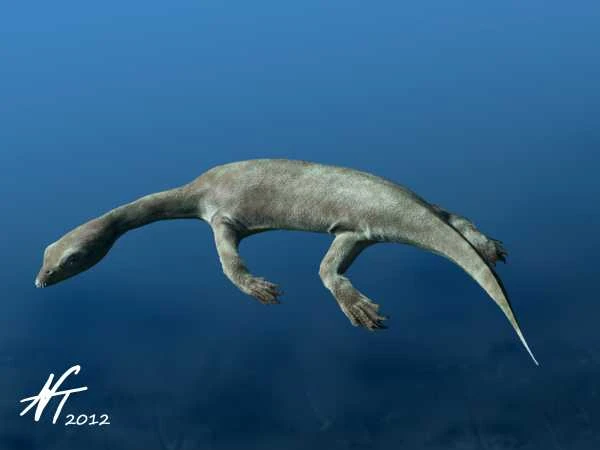Qianxisaurus is an extinct genus of pachypleurosaur or alternatively a basal eosauropterygian known from the Middle Triassic (Ladinian age) of Guizhou Province, southwestern China. It contains a single species, Qianxisaurus chajiangensis.
Discovery[]
Qianxisaurus is known solely from the holotype NMNS-KIKO-F044630, a nearly complete and articulated skeleton missing only the tip of the tail and the right hindlimb, housed at the National Museum of Natural Science in Taichung, Taiwan. The holotype is exposed mostly in a view from above, with the tail gradually turning to left side view. The skull measures at 7.6 cm in length, and the total length of the preserved parts of the individual is 76.8 cm. Only the first 31 tail vertebrae are preserved, out of at least 42-48 vertebrae that are expected to comprise the tail based on other closely related pachypleurosaurs, which implies a total body length longer than 80 cm for this individual. NMNS-KIKO-F044630 was discovered in 2006 near the Huangnihe River at Chajiang of Xingyi, southwestern-most Guizhou Province. It was most probably collected from the Zhuganpo Member of the Falang Formation based on field expeditions to the area in 2006, somewhere between the Geju railway station and Chajiang railway station along the east side of the river which is the provincial boundary between Guizhou and Yunnan, thus dating to the Ladinian stage of the late Middle Triassic, about 238 million years ago.
Etymology[]
Qianxisaurus was first described and named by Yen-Nien Cheng, Xiao-Chun Wu, Tamaki Sato and Hsi-Yin Shan in 2012 and the type species is Qianxisaurus chajiangensis. The generic name is derived from Qianxi, which refers to the western part of Guizhou Province where the holotype was found, a spelling based on the Chinese Pinyin, and from Greek saurus, meaning "lizard", a common suffix for genus names of extinct reptiles. The specific name is derived from Chajiang, a town near which the specimen was collected, with the edition of the Greek suffix -ensis, meaning "from".
